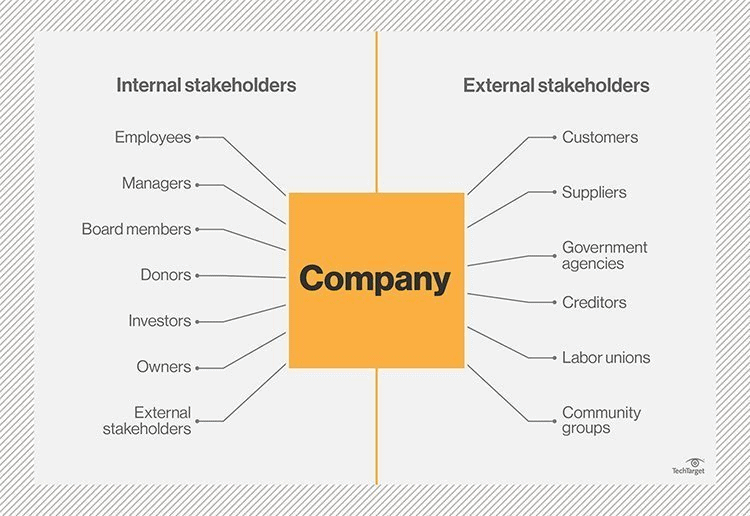
A stakeholder is a person or a group who has an interest in the actions of a company. They can be a part of the company, or outside it. Their ideas can affect what the company does. They are important for the company to do well.
The international rules from ISO 26000 help to know who a stakeholder is:
- A company has legal duties towards stakeholders.
- They can be affected by the company’s choices.
- They usually share their thoughts and take part in what the company does.
Stakeholders often are customers, workers, people who have put money in the company, suppliers, directors, people in the community, other groups, and government bodies. There is a system called stakeholder capitalism where a company puts the stakeholders’ needs first.
The word “stakeholder” came from horse racing. In a stake race, the prize money comes from the fees that horse owners pay. This fee is called a stake, which means risk.
The person who keeps the fees till the prize money is given out is called the stakeholder. In the past, the stakeholder didn’t have money at risk in the race’s result.
You may also like: Calculating company valuations. Everything there is to know
What is a stakeholder?
A stakeholder is a person or group that has a concern in a business and can either influence or be influenced by the business. The main stakeholders in a usual company are its investors, workers, buyers, and providers.
With more focus on company’s responsibility towards society, now even communities, governments, and trade groups are considered stakeholders.
Understanding stakeholders
Stakeholders can be from inside or outside a company. Inside stakeholders are people who have a direct connection with a company like a job, ownership, or investment.
Outside stakeholders are those who do not have a direct connection with a company but are affected in some way by what the company does. Providers, creditors, and public groups fall in this category.
Example of an inside stakeholder
Investors are inside stakeholders who are greatly affected by the company’s performance.
For instance, if a venture capital company decides to invest ₹35 crore in a technology startup for 10% share and big influence, the company becomes an inside stakeholder of the startup.
The venture capital company’s return on investment depends on whether the startup succeeds or fails, showing the company has a big interest.
Also Read: A guide to value investing in India
External Stakeholder Example
External stakeholders are not part of the company, but they get affected by its operations. If a company in a town crosses the allowed carbon emissions, the town becomes an external stakeholder due to the pollution.
Likewise, the government is an external stakeholder. If it changes carbon emission policies, it impacts the business activities of companies emitting more carbon.

Issues concerning stakeholders
Companies face problems when stakeholder interests clash. For instance, a company might want to keep labor costs low for more profits which shareholders like. But, this can upset the employees, another stakeholder group. Efficient companies balance the needs and expectations of all stakeholders management well.
Stakeholders vs. shareholders
Shareholders are a subset of stakeholders invested for financial gains, they can sell their shares anytime. Other stakeholders management have a long-term interest tied to the company’s well-being.
For instance, if a company performs badly, it might cut down production, affecting the vendors and possibly leading to job losses for employees. However, shareholders can limit their losses by selling their shares.
| Aspect | Stakeholders | Shareholders |
| Definition | Individuals or groups with an interest in the company’s well-being either directly or indirectly. | Subset of stakeholders invested for financial gains. |
| Interest | Long-term interest tied to the company’s well-being. | Primarily interested in financial gains. |
| Investment | Interest can be in form of employment, supplies, or community involvement. | Monetary investment through buying shares of the company. |
| Risk Management | Their interests are tied to the company, so they may face job loss or business loss during tough times. | Can limit losses by selling shares during tough times. |
| Example Impact | If a company performs badly, it might affect vendors and lead to job losses for employees. | Shareholders can sell shares to limit financial losses. |
| Relationship with Company | They can be internal or external and have a more holistic relationship with the company. | Primarily financial relationship with the company. |
Also Read: Your comprehensive guide to successful share market investing
Types of stakeholders
Stakeholders are linked to an organization or project in different ways. Here are the usual types of stakeholders:
- Customers look for valuable products from organizations.
- Employees, often tied to projects related to their work, are keen to contribute.
- Owners provide the money for the organization and set its goals.
- Investors buy shares in organizations for financial gains. They get regular updates on the company’s money matters and can vote on big decisions.
- Creditors like banks lend money to the organisation, which needs to be returned with some extra money (interest).
- Suppliers provide materials and products, having a stake in the business and its projects.
- Communities benefit from businesses that are safe and add to the local economy. Businesses provide jobs and business activities locally. Environment, sustainability, and governance (ESG) are values that matter more now to customers and investors.
- Governments get taxes from companies and the people working there.
Stakeholders in a business
Stakeholders are individuals or groups directly or indirectly connected to a company’s functioning, its success, or failure. Initially, there are the owners. They actively participate or are passive investors.
If the company has loans, creditors like banks become stakeholders. Employees, forming the next group, along with suppliers, depend on the business for income. Customers purchasing and utilizing the products or services are also stakeholders.
Importance of Stakeholders
Stakeholders are crucial as the company’s workings depend on their collective efforts towards achieving business objectives. Internal stakeholders management have a direct impact, while external stakeholders influence indirectly.
For example, customers may alter buying preferences, suppliers can modify manufacturing processes, and government regulations can change. Managing these relationships is vital for the business’s enduring success.
What are Stakeholders’ Interests?
Stakeholders have a variety of interests depending on their relationship with a business. These interests shape how they interact with the company and what they expect in return.
Typically, stakeholders are concerned with aspects of a business that affect their financial, social, or operational well-being.
For example, investors focus on the profitability of a company and expect a solid return on investment and transparency in financial reporting. Employees, on the other hand, are interested in job security, fair compensation, and a conducive working environment.
Customers look for high-quality products and services at reasonable prices, and may also prioritise the ethical practices of a company, such as environmental sustainability. Suppliers aim for long-term partnerships with predictable demand and timely payments, while government bodies are concerned with the company adhering to regulations, contributing to tax revenues, and supporting local employment.
With the rise of corporate social responsibility (CSR) initiatives in India, communities have also become crucial stakeholders management. They expect businesses to contribute positively to local development, protect the environment, and follow fair business practices.
When aligned, the interests of a stakeholder can lead to business growth, but if neglected, they can pose risks to a company’s sustainability.
Importance of Stakeholder Management
Effective stakeholder management is essential for a business’s long-term success. It helps ensure that the interests and needs of different groups are considered and addressed.
It minimises conflicts and promotes collaboration. Companies that implement strong stakeholder management strategies tend to build stronger relationships with their stakeholders, leading to greater loyalty, smoother operations, and better risk management.
Businesses that actively engage stakeholders with the help of regular communication, transparency, and responsiveness can get social acceptance, which is especially important for industries dealing with public goods like energy or infrastructure. This social acceptance often leads to smoother project execution and better community relations.
Effective stakeholder management also boosts a company’s reputation, which in turn can lead to higher sales, improved market value, and sustained growth.
Effective management of stakeholders involves balancing conflicting interests, ensuring transparency, and developing strategies that integrate both internal and external perspectives. This will enhance decision-making, reduce operational surprises, and result in better overall project outcomes.
The bottom line
Stakeholders have a stake in the business outcomes. They could be internal like employees, or external like customers and government bodies.
They vary from customers shareholders to communities, impacting the business in different ways.

